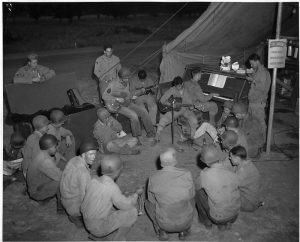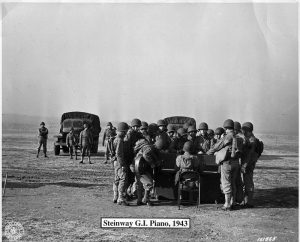Pianos for Victory
This story has been brought to my attention twice in the last 48 hours from two different sources.* Sometimes the universe says “You need to write a blog post about this!” in a very clear voice.
When the United States entered World War II in 1941, raw materials of all sorts were diverted to the war effort and manufacturers retooled their plants to produce war material. (Typewriters were an interesting example of this.)
At first, the Steinway piano company used its capacity for making big wooden boxes to manufacture tails and wings for gliders for troop transport and coffins for bringing casualties home. Late in 1941, the company received a request from the War Production Board to design a small upright piano that could be made inexpensively and shipped in a crate to soldiers in the field. The first prototypes were ready by June, 1942.
The pianos were designed to stand up to wartime conditions, without access to the materials the company would normally use. They didn’t have front legs because legs might have broken off when airdropped. They used only one-tenth the metal of a regular Steinway. (Just because the government ordered the pianos didn’t mean Steinway had access to the metals they used to make pianos in peacetime.) They had celluloid keys instead of ivory. The wood was treated with insect repellent and the glue was water resistant.
Known as “Victory Vertical” pianos and “G.I. Steinways,” the pianos were 40-inches tall and weighed 455 pounds. They were made with handles under the keybed and in the back, making it easy for four soldiers to carry them. They were shipped, and sometimes airdropped onto the battlefield, with a set of tuning tools, instructions for using them, spare parts, and sheet music, including current popular music for sing-alongs, Protestant hymns, and boogie-woogie tunes.
The first shipment of 405 olive drab pianos were greeted with enthusiasm, and were quickly followed by more. Later pianos were painted in olive drab, blue, or gray depending on the service to which they were shipped.
The Steinway company shipped more than 3,000 Victory Vertical pianos between 1943 and 1953, when production ended. The last of the pianos went into service in 1961, when the captain of the newly built nuclear submarine USS Thomas A. Edison requested that one be installed in the crew’s mess area. It remained on board until the sub was decommissioned in 1983 and is now on display in the Navy Historical Center in Washington, D.C.
*With thanks. Keep those stories coming, y’all.






